Comparison of Ground-Based and Satellite-Derived Solar UV Index Levels at Six South African Sites
Abstract
:1. Introduction
2. Data and Methods
2.1. Ground-Based Solar UVR Data
2.2. Satellite-Derived Solar UVR Levels
2.3. Methods and Statistical Analysis
3. Results
3.1. Ground-Based Solar UVR Observations
3.2. Satellite-Derived Solar UVR Measurements
3.3. Comparison of Ground-Based and Satellite-Derived Solar UVR Data
4. Discussion
- OMI resolution can be a factor of this difference. Indeed, OMI data are integrated on a pixel of 1° × 1° (square of 110 km). In a region where cloud cover changes widely, it can quickly appear as a large difference with local data. A 1° × 1° pixel can also include a mountain and it is not taking into consideration the surface albedo, which may also have an effect [10,21,30,31]. This is evident at Cape Town and Cape Point stations. Ground-based observations show an evident difference, but this difference is transparent to the satellite.
- Aerosols play an important part in the UVR response [30]. Global climatological aerosol datasets are used in OMI processing, but this is likely not relevant for an isolated, relatively clear site, like De Aar station, although wind-blown dust may be a factor.
5. Conclusions
Acknowledgments
Author Contributions
Conflicts of Interest
References
- Diffey, B.L. Solar ultraviolet radiation effects on biological systems. Phys. Med. Biol. 1991, 36, 299–328. [Google Scholar] [CrossRef] [PubMed]
- International Commission on Non-Ionizing Radiation Protection. Guidelines on limits of exposure to ultraviolet radiation of wavelengths between 180 nm and 400 nm. Health Phys. 2004, 87, 171–186. [Google Scholar]
- McKinlay, A.F.; Diffey, B.L. A reference action spectrum for ultraviolet induced erythema in human skin. CIE J. 1989, 6, 17–22. [Google Scholar]
- WHO (World Health Organization). Global Solar UV Index; A Practical Guide; WHO Report; World Health Organization: Geneva, Switzerland, 2002; Available online: http://www.who.int/uv/publications/en/UVIGuide.pdf (accessed on 25 October 2017).
- Von Schirnding, Y.; Strauss, N.; Mathee, A.; Robertson, P.; Blignaut, R. Sunscreen use and environmental awareness among beach-goers in Cape Town, South African. Public Health Rev. 1991, 19, 209–217. [Google Scholar] [PubMed]
- Sitas, F. Histologically diagnosed cancers in South Africa, 1988. S. Afr. Med. J. 1994, 84, 344–348. [Google Scholar] [PubMed]
- Bodeker, G.E.; Scourfield, M.W.J. Estimated past and future variability in UV radiation in South Africa based on trends in total column ozone. S. Afr. J. Sci. 1998, 94, 24–33. [Google Scholar]
- Prause, A.R.; Scourfield, M.W.J. Surface erythema irradiance and total column ozone above Durban, South Africa, for the period 1996–1998. S. Afr. J. Sci. 2002, 98, 186–188. [Google Scholar]
- Brogniez, C.; Auriol, F.; Deroo, C.; Arola, A.; Kujanpää, J.; Sauvage, B.; Kalakoski, N.; Pitkänen, M.R.A.; Catalfamo, M.; Metzger, J.-M.; et al. Validation of satellite-based noontime UVI with NDACC ground-based instruments: Influence of topography, environment and satellite overpass time. Atmos. Chem. Phys. 2016, 16, 15049–15074. [Google Scholar] [CrossRef]
- Bernhard, G.; Arola, A.; Dahlback, A.; Fioletov, V.; Heikkilä, A.; Johnsen, B.; Koskela, T.; Lakkala, K.; Svendby, T.; Tamminen, J. Comparison of OMI UV observations with ground-based measurements at high northern latitudes. Atmos. Chem. Phys. 2015, 15, 7391–7412. [Google Scholar] [CrossRef] [Green Version]
- Jégou, F.; Godin-Beekman, S.; Corrrea, M.P.; Brogniez, C.; Auriol, F.; Peuch, V.H.; Haefffelin, M.; Pazmino, A.; Saiag, P.; Goutail, F.; et al. Validity of satellite measurements used for the monitoring of UV radiation risk on health. Atmos. Chem. Phys. 2011, 11, 13377–13394. [Google Scholar] [CrossRef] [Green Version]
- Kazadzis, S.; Bais, A.; Arola, A.; Krotkov, N.; Kouremeti, N.; Meleti, C. Ozone Monitoring Instrument spectral UV irradiance products: Comparison with ground based measurements at an urban environment. Atmos. Chem. Phys. 2009, 9, 585–594. [Google Scholar] [CrossRef]
- Madronich, S.; Mayer, B.; Fischer, C.A. A Climatology of Erythemal Ultraviolet Radiation, 1979–1992; NATO Advanced Study Institute (ASI), Chemistry and Radiation Changes in the Ozone Layer: Lokympari, Crete, Greece, 1999. [Google Scholar]
- Varotsos, C. Solar ultraviolet radiation and total ozone, as derived from satellite and ground-based instrumentation. Geophys. Res. Lett. 1994, 21, 1787–1790. [Google Scholar] [CrossRef]
- Zempila, M.M.; Koukouli, M.E.; Bais, A.; Fountoulakis, I.; Arola, A.; Kouremeti, N.; Balis, D. OMI/Aura UV product validation using NILU-UV ground-based measurements in Thessaloniki, Greece. Atmos. Environ. 2016, 140, 283–297. [Google Scholar] [CrossRef]
- Janjai, S.; Wisitsirikun, S.; Buntoung, S.; Pattarapanitchai, S.; Wattan, R.; Masiri, I.; Bhattarai, B.K. Comparison of UV index from Ozone Monitoring Instrument (OMI) with multi-channel filter radiometers at four sites in the tropics: Effects of aerosols and clouds. Int. J. Climatol. 2014, 34, 453–461. [Google Scholar] [CrossRef]
- Fan, L.; Li, W.; Dahlback, A.; Stamnes, J.J.; Stamnes, S.; Stamnes, K. Long-term comparisons of UV index values derived from a NILU-UV instrument, NWS, and OMI in the New York area. Appl. Opt. 2015, 54, 1945–1951. [Google Scholar] [CrossRef] [PubMed]
- Kerr, J.B.; Seckmeyer, G.; Bais, A.F.; Bernhard, G.; Blumthaler, M.; Diaz, S.B.; Krotkov, N.; Lubin, D.; McKenzie, R.L.; Sabziparvar, A.A.; et al. Surface ultraviolet radiation: Past and future, Chapter 5. In Scientific Assessment of Ozone Depletion; 2002. Available online: https://acd-ext.gsfc.nasa.gov/Documents/O3_Assessments/Docs/WMO_2002/10_chapter5.pdf (accessed on 25 October 2017).
- Seckmeyer, G.; Bais, A.; Bernhard, G.; Blumthaler, M.; Booth, C.R.; Lantz, K.; Webb, A. Instruments to Measure Solar Ultraviolet Radiation. Part 2: Broadband Instruments Measuring Erythemally Weighted Solar Irradiance; WOM-GAW Report; World Meteorological Organization (WMO): Geneva, Switzerland, 2005. [Google Scholar]
- McKenzie, R.; Smale, D.; Kotkamp, M. Relationship between UVB and erythemally weighted radiation. Photochem. Photobiol. Sci. 2004, 3, 252–256. [Google Scholar] [CrossRef] [PubMed]
- Ozone Monitoring Instrument (OMI). OMI Algorithm Theoretical Basis Document Version III; Stammes, P., Noordhoek, R., Eds.; ATBD-OMI-03, Version 2.0, August 2002; Ozone Monitoring Instrument (OMI): Netherlands’s Agency for Aerospace Programs (NIVR), Netherland, and Finnish Meteorological Institute (FMI): Helsinki, Finland, 2002. Available online: http://eospso.gsfc.nasa.gov/sites/default/files/atbd/ATBD-OMI-03.pdf (accessed on 25 October 2017).
- Arola, A.; Kazadzis, S.; Lindfors, A.; Krotkov, N.; Kujanpää, N.; Tamminen, J.; Bais, A.; di Sarra, A.; Villaplana, J.M.; Brogniez, C.; et al. A new approach for absorbing aerosols in OMI UV. Geophys. Res. Lett. 2009, 36, L22805. [Google Scholar] [CrossRef]
- Giovanni Platform, NASA Earth Data. Available online: https://giovanni.gsfc.nasa.gov/giovanni/ (accessed on 8 November 2017).
- Ozone Monitoring Instrument (OMI) Team. Data User’s Guide; Ozone Monitoring Instrument (OMI): Netherlands’s Agency for Aerospace Programs (NIVR), Netherland, and Finnish Meteorological Institute (FMI): Helsinki, Finland, 2012.
- Antón, M.; Cachorro, V.E.; Vilaplana, J.M.; Toledano, C.; Krotkov, N.A.; Arola, A.; Serrano, A.; de la Morena, B. Comparison of UV irradiances from Aura/Ozone Monitoring Instrument (OMI) with Brewer measurements at El Arenosillo (Spain)—Part 1: Analysis of parameter influence. Atmos. Chem. Phys. 2010, 10, 5979–5989. [Google Scholar] [CrossRef] [Green Version]
- Wright, C.Y.; Coetzee, G.; Ncongwane, K. Ambient solar UV radiation and seasonal trends in potential sunburn risk among schoolchildren in South Africa. S. Afr. J. Child Health 2011, 5, 33–38. [Google Scholar]
- Ncongwane, K.P. Erythemally-Weighted UV Radiation Measurements at Six South African Sites. Master’s Thesis, University of KwaZulu-Natal, Durban, South Africa, 2015. [Google Scholar]
- Ncongwane, K.; Coetzee, G. A quantitative analysis of the SAWS GAW UV network and data since 1994. In Proceedings of the South African Society for Atmospheric Sciences Conference (SASAS), Gariep Dam, South Africa, 20–22 September 2010; pp. 20–22. [Google Scholar]
- McKenzie, R.; Kotkamp, M.; Seckmeyer, G.; Erb, R.; Roy, C.R.; Gies, H.P.; Toomey, S.J. First southern hemisphere intercomparison of measured solar UV spectra. Geophys. Res. Lett. 1993, 20, 2223–2226. [Google Scholar] [CrossRef]
- Kazadzis, S.; Bais, A.; Kouremeti, N.; Zemplila, M.; Arola, A.; Giannakaki, E.; Amiridis, V.; Kazantzidis, A. Spatial and temporal UV irradiance and aerosol variability within the area of an OMI Satellite pixel. Atmos. Chem. Phys. 2009, 9, 4593–4601. [Google Scholar] [CrossRef]
- Weihs, P.; Blumthaler, M.; Rieder, H.E.; Kreuter, A.; Simic, S.; Laube, W.; Schmalwieser, A.W.; Wagner, J.E.; Tanskanen, A. Measurements of UV irradiance within the area of one satellite pixel. Atmos. Chem. Phys. 2008, 8, 5615–5626. [Google Scholar] [CrossRef]
- Toihir, A.M.; Bencherif, H.; Sivakumar, V.; Amraoui, L.E.; Portafaix, T.; Mbatha, N. Comparison of total column ozone obtained by the IASI-MetOp satellite with ground-based and OMI satellite observations in the southern tropics subtropics. Ann. Geophys. 2015, 33, 1135–1146. [Google Scholar] [CrossRef] [Green Version]
- Buchard, V.; Brogniez, C.; Auriol, F.; Bonnel, B.; Lenoble, J.; Tanskanen, A.; Bojkov, B.; Veefkind, P. Comparison of OMI ozone and UV irradiance data with ground-based measurements at two French sites. Atmos. Chem. Phys. 2008, 8, 4517–4528. [Google Scholar] [CrossRef]
- Zempila, M.M.; Giannaros, T.M.; Bais, A.; Melas, D.; Kazantzidis, A. Evaluation of WRF shortwave radiation parameterizations in predicting Global Horizontal Irradiance in Greece. Renew. Energy 2016, 86, 831–840. [Google Scholar] [CrossRef]
- Vasaras, A.; Bais, A.F.; Feister, U.; Zerefos, C.S. Comparison of two methods for cloud flagging of spectral UV measurements. Atmos. Res. 2001, 57, 31–42. [Google Scholar] [CrossRef]
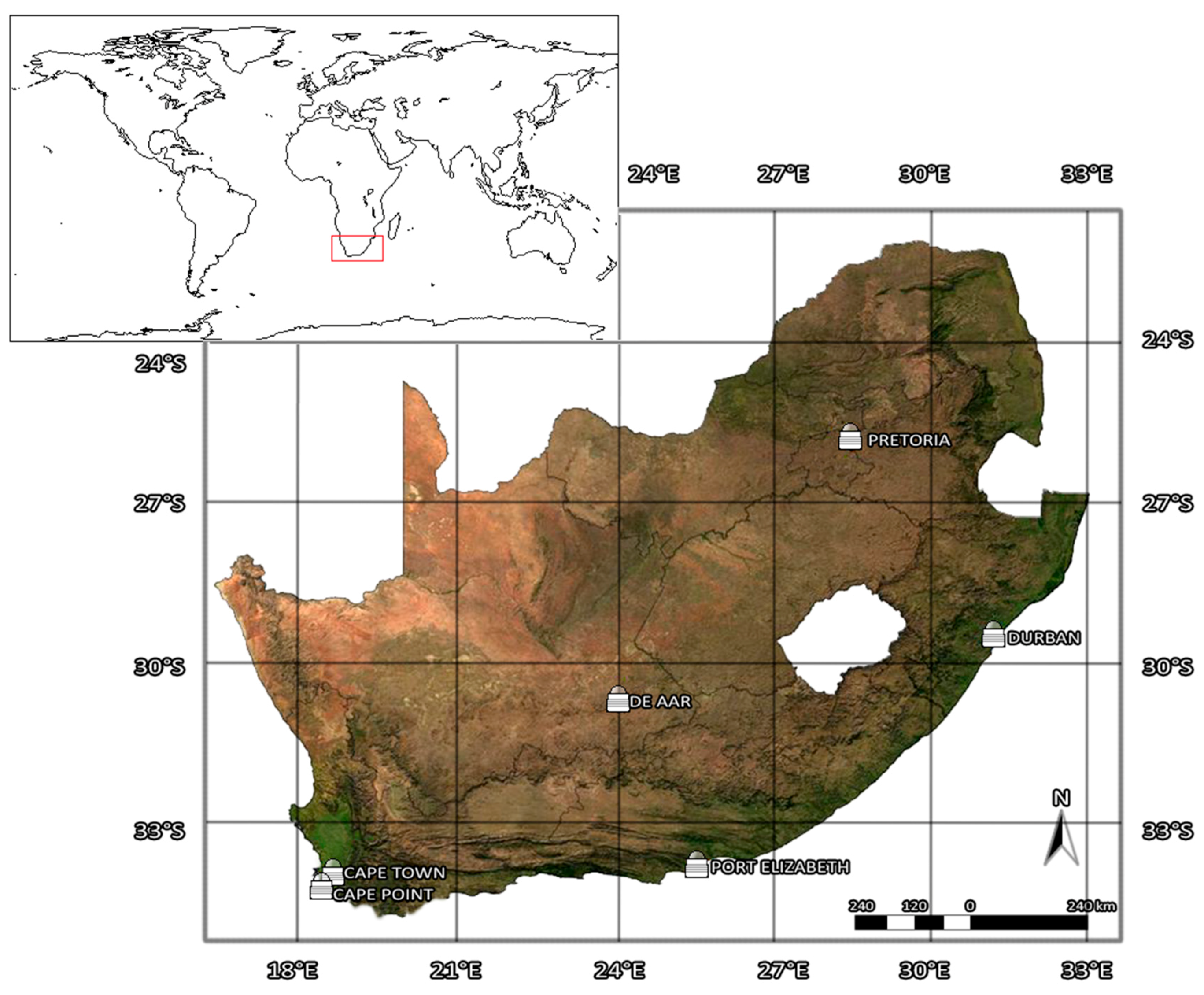
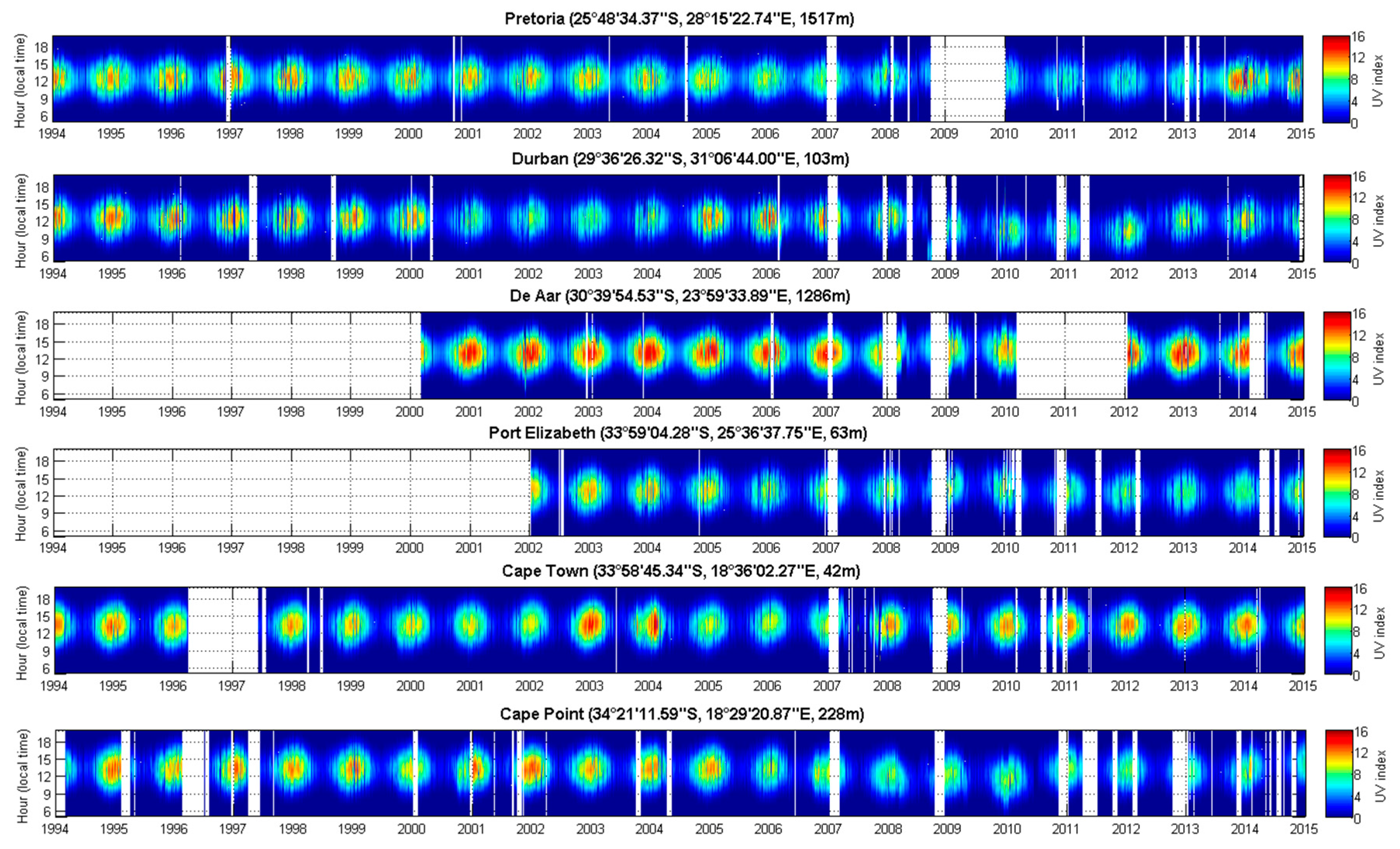

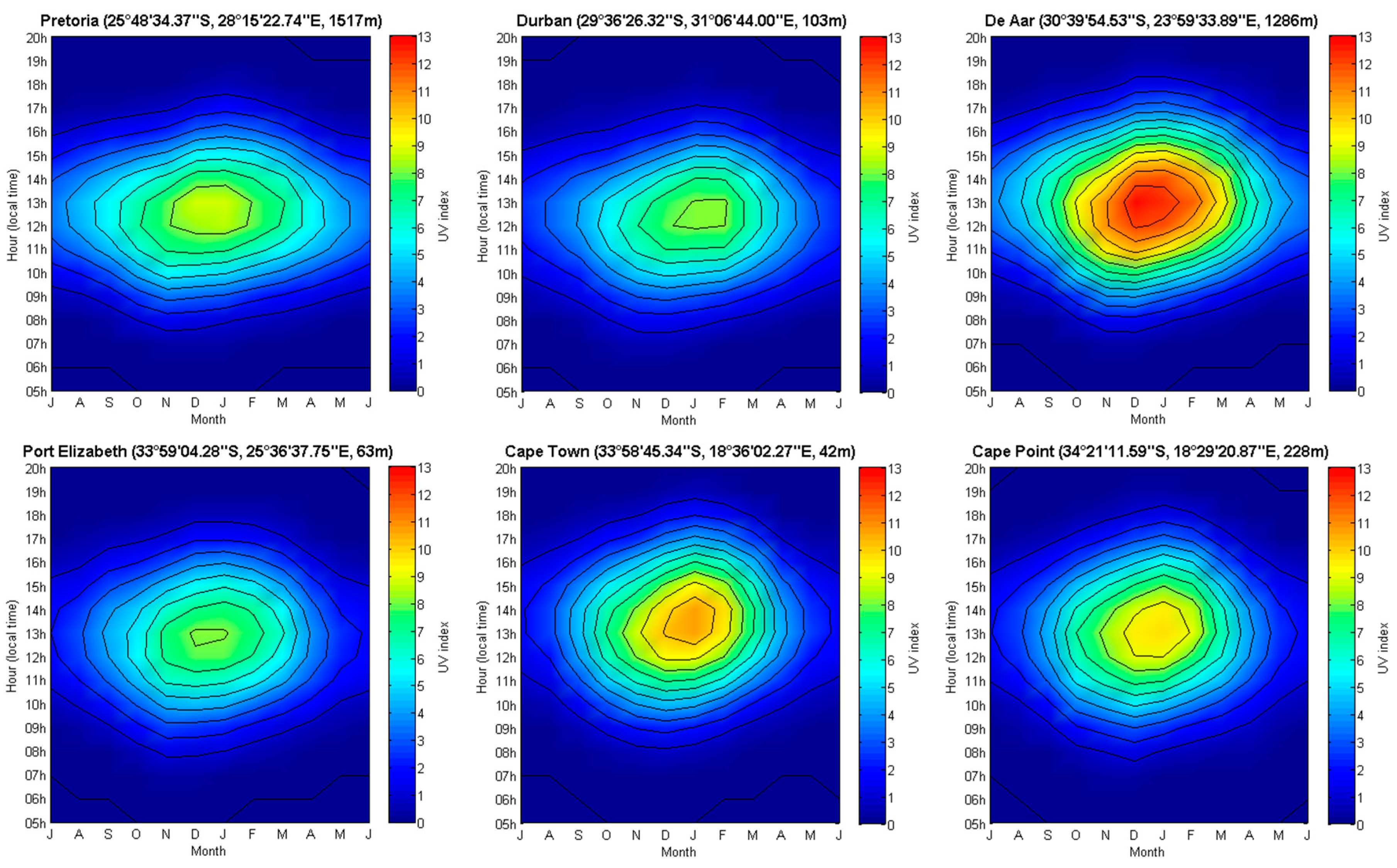
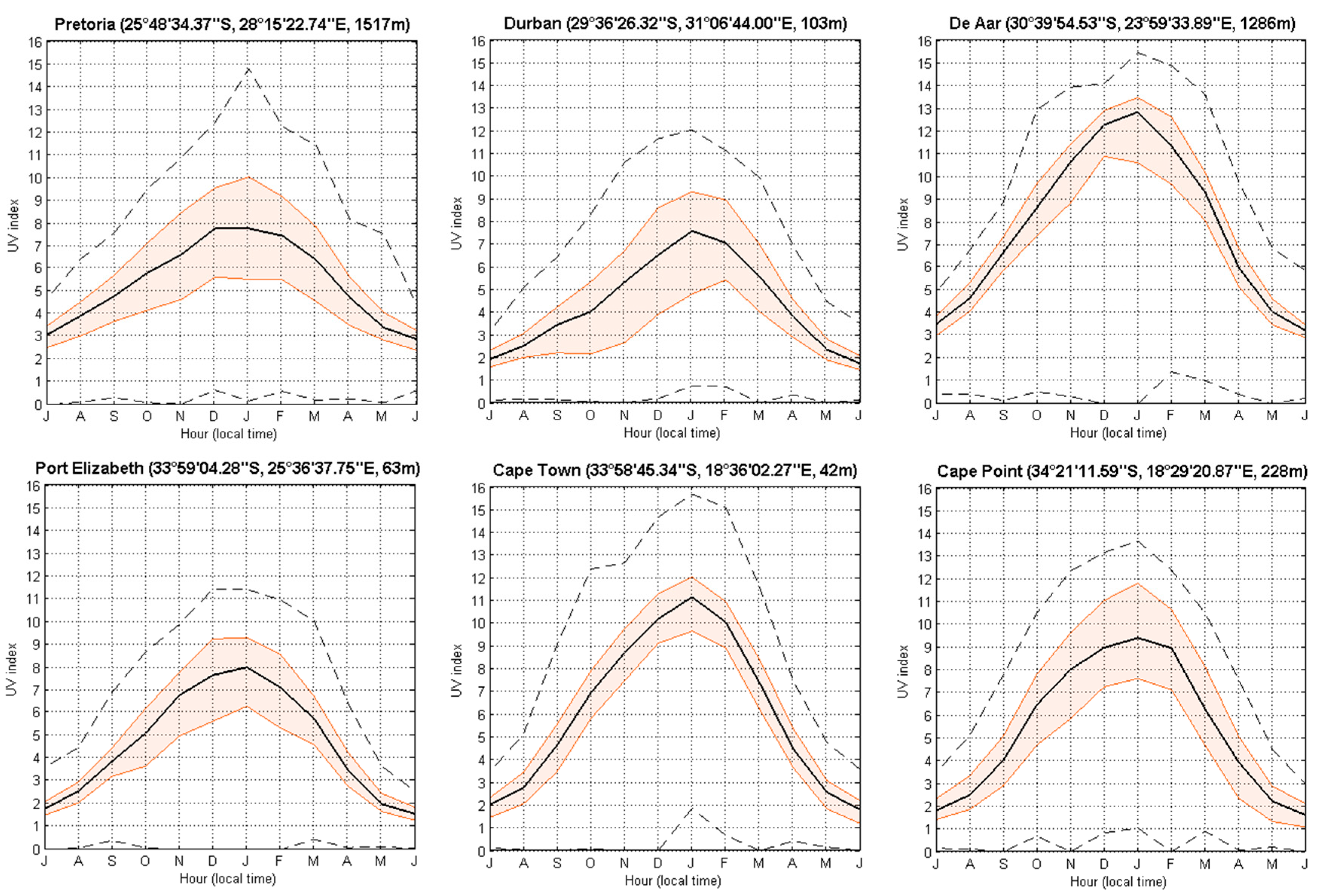

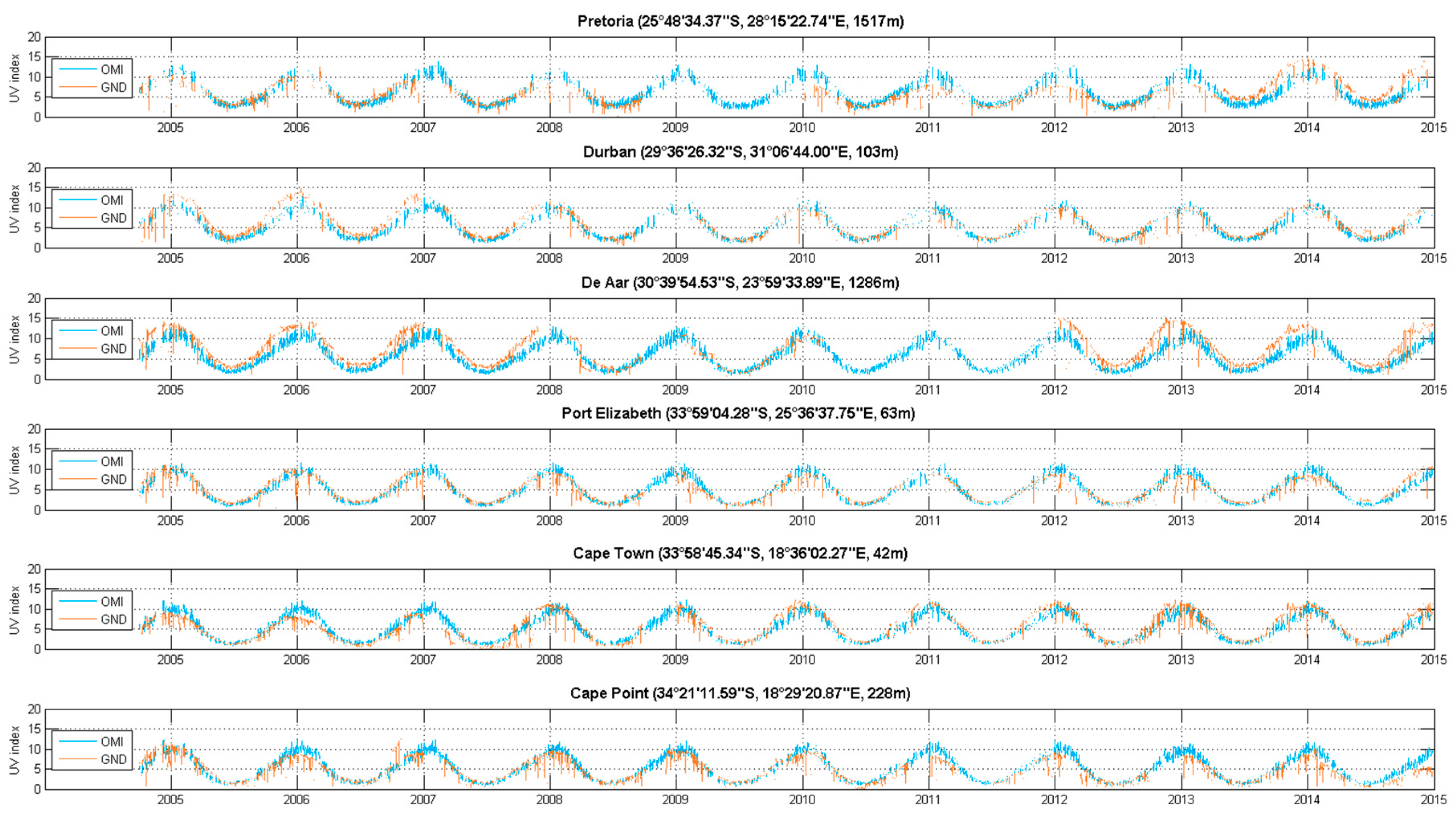

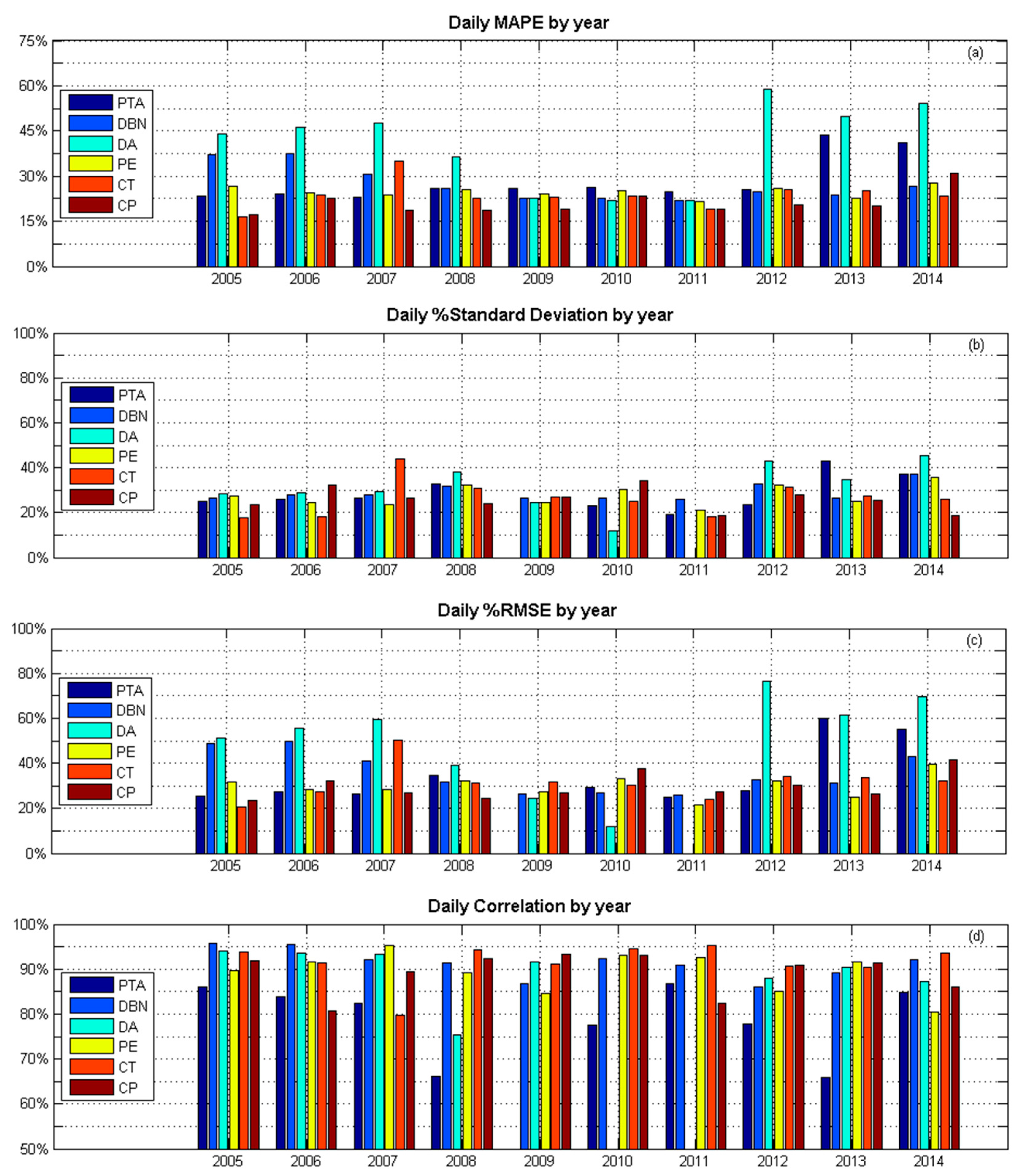
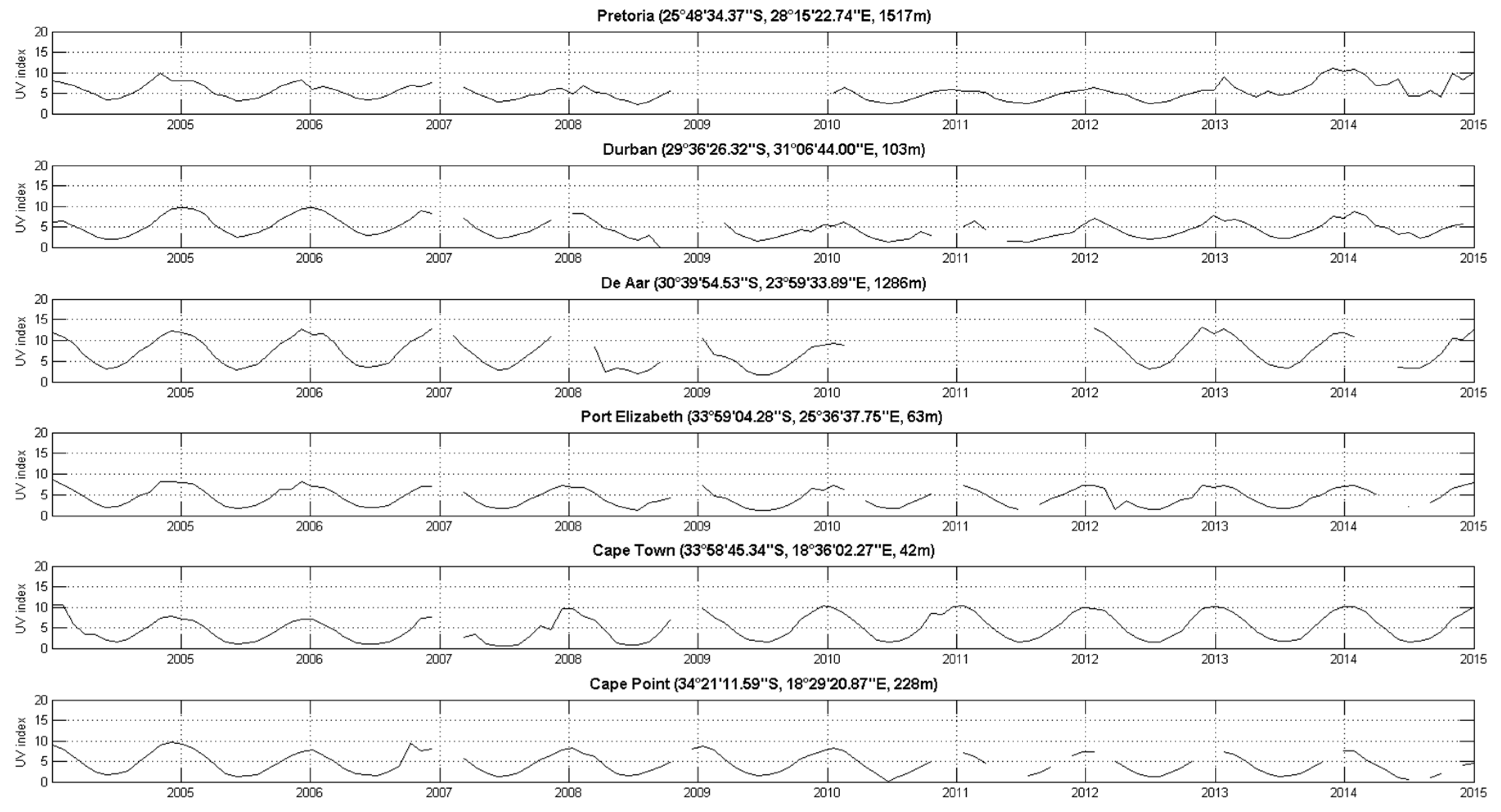
| Station | Geographical Position | Coordinates | Altitude | Time Series |
|---|---|---|---|---|
| Pretoria | 1—FORUM Building | 25.73° S, 28.18° E | 1330 m | 1994 to May 2003 |
| 2—Erasmusrand | 25.81° S, 28.49° E | 1228 m | May 2003 to present | |
| Durban | 1—Louis Botha Airport | 29.97° S, 31.00° E | 9 m | 1994 to May 2010 |
| 2—King Shaka Airport | 29.61° S, 31.11° E | 103 m | May 2010 to present | |
| De Aar | 1—SAWS Building | 30.67° S, 23.99° E | 1286 m | 2002 to present |
| Port Elisabeth | 1—Port Elizabeth Airport | 33.97° S, 25.61° E | 63 m | 2000 to present |
| Cape Town | 1—Cape Town Intl Airport | 33.98° S, 18.60° E | 42 m | 1994 to present |
| Cape Point | 1—GAW station | 34.35° S, 18.48° E | 228 m | 1997 to present |
| Site | Number of Observation | Bias | MAPE | Median | SD #1 | RMSE | R2 Value | p Value #2 |
|---|---|---|---|---|---|---|---|---|
| n | UVI | % | UVI | UVI | UVI | % | p | |
| Pretoria | 1578 | −0.15 | 27.3 | 0.15 | 1.93 | 1.93 | 71.0 | <0.001 |
| Durban | 1448 | −0.59 | 28.8 | 0.59 | 1.48 | 1.57 | 88.5 | <0.001 |
| De Aar | 1715 | −1.73 | 46.5 | 1.67 | 1.85 | 2.57 | 87.9 | <0.001 |
| Port Elizabeth | 1540 | −0.19 | 23.1 | 0.34 | 1.46 | 1.46 | 84.9 | <0.001 |
| Cape Town | 1827 | −0.12 | 24.6 | 0.18 | 1.57 | 1.58 | 88.4 | <0.001 |
| Cape Point | 1694 | 0.57 | 22.2 | −0.28 | 1.51 | 1.62 | 87.4 | <0.001 |
© 2017 by the authors. Licensee MDPI, Basel, Switzerland. This article is an open access article distributed under the terms and conditions of the Creative Commons Attribution (CC BY) license (http://creativecommons.org/licenses/by/4.0/).
Share and Cite
Cadet, J.-M.; Bencherif, H.; Portafaix, T.; Lamy, K.; Ncongwane, K.; Coetzee, G.J.R.; Wright, C.Y. Comparison of Ground-Based and Satellite-Derived Solar UV Index Levels at Six South African Sites. Int. J. Environ. Res. Public Health 2017, 14, 1384. https://doi.org/10.3390/ijerph14111384
Cadet J-M, Bencherif H, Portafaix T, Lamy K, Ncongwane K, Coetzee GJR, Wright CY. Comparison of Ground-Based and Satellite-Derived Solar UV Index Levels at Six South African Sites. International Journal of Environmental Research and Public Health. 2017; 14(11):1384. https://doi.org/10.3390/ijerph14111384
Chicago/Turabian StyleCadet, Jean-Maurice, Hassan Bencherif, Thierry Portafaix, Kévin Lamy, Katlego Ncongwane, Gerrie J. R. Coetzee, and Caradee Y. Wright. 2017. "Comparison of Ground-Based and Satellite-Derived Solar UV Index Levels at Six South African Sites" International Journal of Environmental Research and Public Health 14, no. 11: 1384. https://doi.org/10.3390/ijerph14111384






